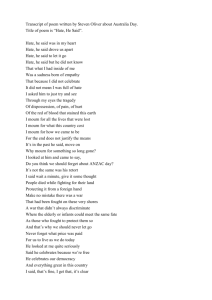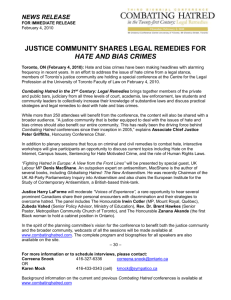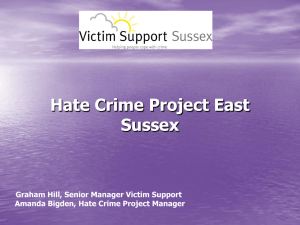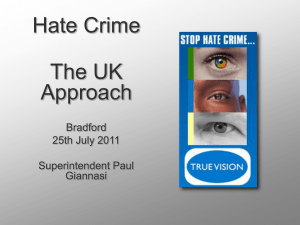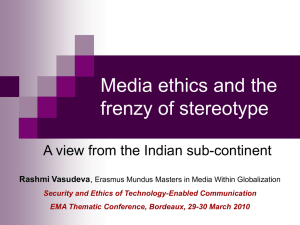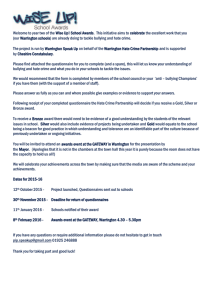Call for Expressions of Interest Mapping of national report systems
advertisement
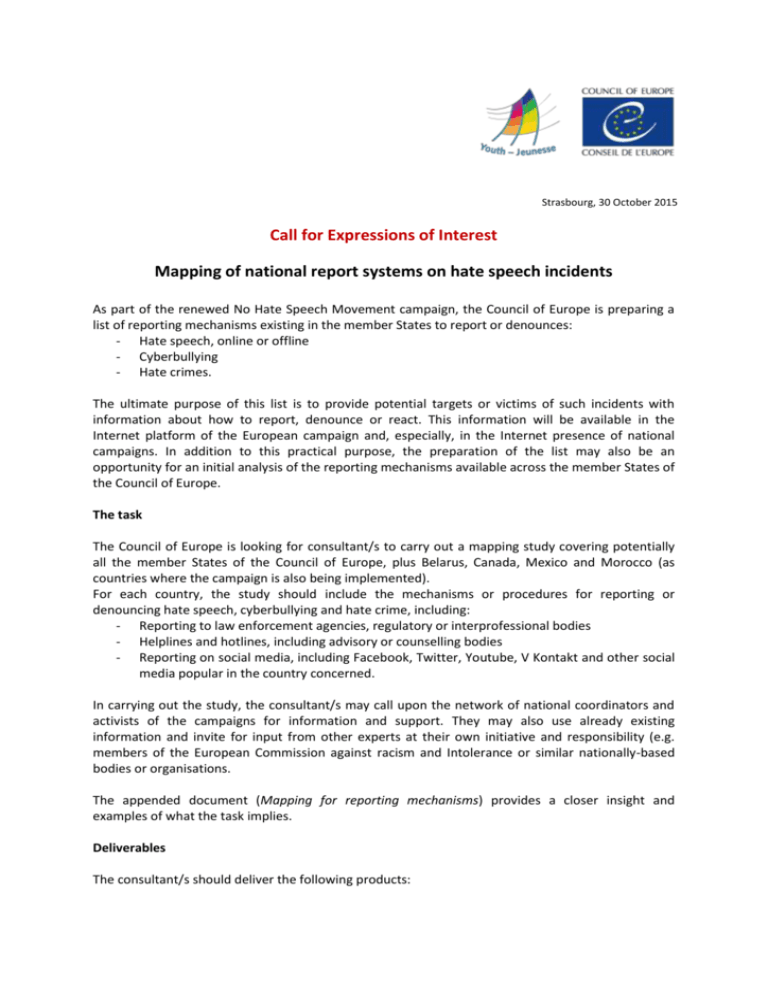
Strasbourg, 30 October 2015 Call for Expressions of Interest Mapping of national report systems on hate speech incidents As part of the renewed No Hate Speech Movement campaign, the Council of Europe is preparing a list of reporting mechanisms existing in the member States to report or denounces: - Hate speech, online or offline - Cyberbullying - Hate crimes. The ultimate purpose of this list is to provide potential targets or victims of such incidents with information about how to report, denounce or react. This information will be available in the Internet platform of the European campaign and, especially, in the Internet presence of national campaigns. In addition to this practical purpose, the preparation of the list may also be an opportunity for an initial analysis of the reporting mechanisms available across the member States of the Council of Europe. The task The Council of Europe is looking for consultant/s to carry out a mapping study covering potentially all the member States of the Council of Europe, plus Belarus, Canada, Mexico and Morocco (as countries where the campaign is also being implemented). For each country, the study should include the mechanisms or procedures for reporting or denouncing hate speech, cyberbullying and hate crime, including: - Reporting to law enforcement agencies, regulatory or interprofessional bodies - Helplines and hotlines, including advisory or counselling bodies - Reporting on social media, including Facebook, Twitter, Youtube, V Kontakt and other social media popular in the country concerned. In carrying out the study, the consultant/s may call upon the network of national coordinators and activists of the campaigns for information and support. They may also use already existing information and invite for input from other experts at their own initiative and responsibility (e.g. members of the European Commission against racism and Intolerance or similar nationally-based bodies or organisations. The appended document (Mapping for reporting mechanisms) provides a closer insight and examples of what the task implies. Deliverables The consultant/s should deliver the following products: - - A list/table of the mechanisms and procedures in each country for each of the areas identified above, including, where relevant, hyperlinks and hotline numbers, as well as a short description/presentation of the general situation in the country – a first draft is to be delivered by 31 December 2015, with the final draft for 15 February 2016. A summary analysis of the situation across Europe and of the possible implication this could/should have for the campaign, to be submitted by 31 January 2016. All deliverables should be provided in English (UK); the names and addresses of the mechanisms should be reproduced in the languages that they are available. Competences required - Good knowledge of hate speech and cyberbullying - Familiar with reporting mechanisms, including judicial ones - Experience with online social media and the mechanisms set to moderate, react to, report or flag hate speech - Familiar with the No Hate Speech Movement campaign - Research and analytical skills - Very good writing skills in English - Preferably knowledgeable on law and regulations pertaining to freedom of expression and media. Multilingualism will be particularly useful and valued. Contract The consultant/s will be proposed two contracts: one for the work to be carried out in 2015 and the second for the work to be delivered in 2016. Further information: rui.gomes@coe.int Procedure for expressions of interest Expressions of interest must be communicated by using the appended form together with a recent CV and samples of any previous similar or relevant work. Joint expressions of interest (i.e. by 2 or more people) should be presented as a single proposal. Deadline for expressions of interest: 15 November 2015. Form for expression of interest Call Mapping of national report systems on hate speech incident Name/s Emails: Telephone/s: Person responsible for the proposal Languages covered 1. Please provide details1 about the competences and experiences of the consultant/s on a) Hate speech and cyberbullying b) Reporting mechanisms, including judicial ones c) Online social media and the mechanisms set to moderate, react to, report or flag hate speech d) The No Hate Speech Movement campaign e) Research and analytical skills f) Law and regulations pertaining to freedom of expression and media. 2. Please provide details about the methodology and timetable envisaged to carry out the mapping study 3. Your estimation of the total number of days required for this work 4. Any Additional information and comments relevant to the assessment of your application: Deadline: 15 November 2015 Form to be returned to: dys.trainers.pool@coe.int Please add a recent CV. 1 details on similar publications, links to Internet sites or previous work are welcome Appendix Mapping for reporting mechanisms Introduction This paper outlines how the Youth Department of the Council of Europe expects to conduct research mapping of the various reporting mechanisms available to young people to report incidents of hate speech, cyberhate, cyberbullying and (online) hate crime, within the framework of the No Hate Speech campaign, in accompaniment with its Hate Speech Watch online tool2. This is important for the future of the campaign which will itself continue until the end of 2017 in the framework of the Council of Europe Plan of Action on the fight against violent extremism and radicalisation leading to terrorism. It is also a call for experts who can contribute to the production of information about reporting mechanisms available to young people in different national contexts. The UK will be used as an example in this paper for various reporting mechanisms available. Methodology In order to map the various mechanisms in which young people can report hate speech, hate speech online (cyberhate) and cyberbullying. Firstly the working group needs to set out clear definitions of what is meant by hate speech, cyberhate, cyberbullying and hate crime. Secondly, various mechanisms to deal with these hate incidences need to be identified; one can react in different ways depending on the severity of the action and the national, legal context. Thirdly, a mapping of general and national-specific reporting mechanisms need to be identified, related to the various different kinds of hateful acts (whether it is considered criminal, is a bullying action etc.) Definitions3 Hate speech ‘The term "hate speech" shall be understood as covering all forms of expression which spread, incite, promote or justify racial hatred, xenophobia, anti‐Semitism or other forms of hatred based on intolerance, including: intolerance expressed by aggressive nationalism and ethnocentrism, discrimination and hostility against minorities, migrants and people of immigrant origin.’ Appendix to RECOMMENDATION No. R (97) 20 of the Committee of Ministers on “Hate Speech"2 broad definition is taken as a starting point. Hate speech online (cyberhate) 2 Found online here: http://www.nohatespeechmovement.org/hate-speech-watch Source used: https://www.coe.int/t/dg4/youth/Source/Training/Training_courses/2012_Mapping_projects_against_Hate_S peech.pdf 3 Additional Protocol to the Convention on Cybercrime3 Article 2.1 For the purposes of this Protocol: "racist and xenophobic material" means any written material, any image or any other representation of ideas or theories, which advocates, promotes or incites hatred, discrimination or violence, against any individual or group of individuals, based on race, colour, descent or national or ethnic origin, as well as religion if used as a pretext for any of these factors. The Council of Europe’s Additional Protocol to the Convention on Cybercrime is concerned only with hate speech which is racist or xenophobic and there are numerous instances of hate directed towards other groups, so we have included instances which ‘promote or incite hatred, discrimination, or violence’ against such groups as well. For example based upon sex, sexual orientation, disability etc. Cyber bullying “Cyberbullying is related to, but is different from, Cyberhate. In a school context, cyberbullying means any electronic communication including, but not limited to, one shown to be motivated by a student's actual or perceived race, colour, religion, national origin, ancestry or ethnicity, sexual orientation, physical, mental, emotional, or learning disability, gender, gender identity and expression, or other distinguishing personal characteristic, or based on association with any person identified above, when the written, verbal or physical act or electronic communication is intended to: (i) Physically harm a student or damage the student's property; or (ii) Substantially interfere with a student's educational opportunities; or (iii) Be so severe, persistent, or pervasive that it creates an intimidating or threatening educational environment; or iv) Substantially disrupt the orderly operation of the school. Responding to Cyberhate, Toolkit for Action (ADL) (Online) Hate crime Hate crimes are criminal acts committed with a bias motive5. Every hate crime has two elements. 1) The act committed is considred a criminal offence under ordinary criminal law. 2) The offender intentionally chose a target with a protected characteristic. A protected characteristic is a characteristic shared by a group, such as “race”, language, religion, ethnicity, nationality or any other similar common factor6 Crime Laws: A Practical Guide, (Warsaw: ODIHR, 2009), p. 167 Identifying the various strategies4 Criminal complaint 4 Source used : https://www.coe.int/t/dg4/youth/Source/Training/Training_courses/2012_Mapping_projects_against_Hate_S peech.pdf Criminal complaint is the appropriate course of action when dealing with cases that: Extensive material on hate sites; Repeated action by an individual or a group; If the activity of an organised group; Or if is directly threatening and provides evidence towards illegality Notification of offensive content to administrator If the domain where such content is hosted is national, the procedure is simple - after finding the contact address, just write an email giving them all relevant information. It is essential to restate the quote, provide a link to the place where it is and refer to the part of their legislation or terms of service that was breached. To find the contact: 1. open http://whois.domaintools.com/ 2. In the search field on the page, write the name of the website 3. The results should show who the domain registrar is, who are the operators, their contacts, etc. In the case of foreign domains follow the procedure described in the next section. Reporting content to ISPs If the website administrator does not respond, you can contact the provider - the company which provides space on their servers for websites hosting such objectionable content. In most cases however, administrators fulfil requests for content removal if it is illegal. Foreign domains 1. open a page with service whois: http://whois.domaintools.com/ 2. find who is the registrar and where a particular page is hosted 3. If the registrar of domain is a real person, this information is very important for possible criminal prosecution as well as the next steps. 4. Given that registrars often prefer to protect their anonymity, they use companies that register domains instead of them. Therefore sometimes it is impossible to ascertain the individual registrar that way. 5. Regardless of whether you managed to find a domain registrar or not, you need to check whether the provider’s rules contain references to the nature of content, such as if inciting hatred is illegal. These rules are often called Terms of Service (ToS), or Acceptable use policy. It is necessary to locate the word “hate” within these Terms or policies. Usually, the provider reserves the right to assess a particular page against these rules. 6. Next step is to write an email to the provider, stating breach of ToS by the author of that content. If the content is on a second level domain, it is necessary to examine the ToS or AUP service at which the content is hosted, e.g. Wordpress 1. find out the address of the parent service 2. Identify ToS or AUP and see whether it contains anything on hateful or illegal content. 3. If the content falls within one of these definitions, write an email to the administrator, or report objectionable content. Social Networks Social Networks allow for quick and easy sharing of content that is not subject to control or administration at the time of posting. Their importance in the last few years has grown exponentially. Facebook contains many groups, events, photos, meeting the definition of cyberhate. In order to handle such huge amounts of information and requests for removal, Facebook has generated the Reporting System. Below is the example of the notification procedure: 1. Do the print screen of a particular post/group/picture 2. Click on the options 3. Select one of the options - Harassing a friend or hate speech or symbol. 4. Ask your friends on Facebook to do the same Facebook evaluates how many requests for removal a particular post, picture, video receives, and depending on the number of requests, administrators decide whether to delete it or not. YouTube 1. Backup your video with download helper 2. to record video to an electronic database 3. to check whether the same user has uploaded similar videos 4. Report video(s) as offensive. Report to third-party complaints bureau’s and organisations Example for the UK INHOPE INHOPE is the International Association of Internet Hotlines. INHOPE coordinates a network of Internet Hotlines all over the world, supporting them in responding to reports of illegal content to make the Internet safer. http://www.inhope.org True Vision Online hate Crime http://www.report-it.org.uk/home On this website, you can: find out what hate crimes or hate incidents are. find out about the ways you can report them. report using the online form. find information about people that can help and support you if you have been a victim. Bullying UK http://www.bullying.co.uk/cyberbullying/ For cyberbullying you can discuss experiences together. The Community Security Trust (National Organisation for Jewish victims) CST is proud to assist the work of the Police in tackling hate crime and preventing terrorism; and we are grateful for the support and encouragement we have received from Police officers of all ranks in our work. TELL MAMA (National Organisation for Muslim Victims) Reporting hate crime to Muslims, online and offline The Monitoring Group TMG is best known for its casework and Helpline service. Indeed these were one of the early drivers for the creation of TMG. In 1980 the Ealing Family Support Group would sit with families facing racial harassment both to provide support and record the incidents Galop LGBT related hate crime You can contact your local police station directly and arrange to make a crime report. Alternatively, you can contact Galop and we may be able to refer you to an LGBTfriendly police officer (often called LGBT Liaison Officers). However, please be aware that calling Galop is not an alternative to calling 999 in an emergency. Reporting the media The Independent Press Standards Organisation The Independent Press Standards Organisation is the regulator for UK newspapers and magazines, since 2014. You can make a report via their website: www.ipso.co.uk The National Union of Journalists’ Code of Conduct The NUJ’s code of conduct set’s out the main rules and codes to be followed by UK and Irish journalism. All journalists joining the NUJ have to sign up and agree they will strive to adhere to its professional principles. Look at the code of conduct here to see if a journalist is violating them: http://www.nuj.org.uk/about/nuj-code/


